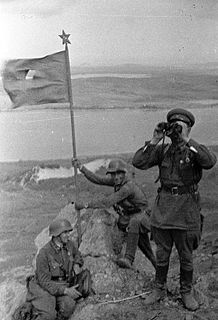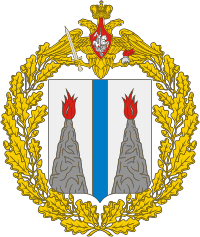Related Research Articles

The Order of the Red Banner was the first Soviet military decoration. The Order was established on 16 September 1918, during the Russian Civil War by decree of the All-Russian Central Executive Committee. It was the highest award of Soviet Russia, subsequently the Soviet Union, until the Order of Lenin was established in 1930. Recipients were recognised for extraordinary heroism, dedication, and courage demonstrated on the battlefield. The Order was awarded to individuals as well as to military units, cities, ships, political and social organizations, and state enterprises. In later years, it was also awarded on the twentieth and again on the thirtieth anniversary of military, police, or state security service without requiring participation in combat.

Vasily Konstantinovich Blyukher was a Soviet military commander and Marshal of the Soviet Union.

The Battle of Lake Khasan, also known as the Changkufeng Incident in China and Japan, was an attempted military incursion by Manchukuo, a Japanese puppet state, into the territory claimed and controlled by the Soviet Union. That incursion was founded in the Japanese belief that the Soviet Union had misinterpreted the demarcation of the boundary based on the Treaty of Peking between Imperial Russia and Qing China and the subsequent supplementary agreements on demarcation and tampered with the demarcation markers. Japanese forces occupied the disputed area but withdrew after heavy fighting and a diplomatic settlement.
The Far Eastern Front was a front — a level of military formation that is equivalent to army group — of the Soviet Army during the Russian Civil War and the Second World War.
The 1st Red Banner Army was a Red Army field army of World War II that served in the Soviet Far East.

The Far Eastern Military District was a military district of the Armed Forces of the Russian Federation. In 2010 it was merged with the Pacific Fleet and part of the Siberian Military District to form the new Eastern Military District.
A rifle corps was a Soviet corps-level military formation during the mid-twentieth century. Rifle corps were made up of a varying number of rifle divisions, although the allocation of three rifle divisions to a rifle corps was common during the latter part of World War II.
The 392nd Pacific Red Banner Order of Kutuzov District Training Center for junior specialists is a training formation of the Russian Ground Forces. It is located in the Khabarovsk area.

Grigory Mikhailovich Shtern was a Soviet officer in the Red Army and military advisor during the Spanish Civil War. He also served with distinction during the Soviet-Japanese Border Wars and the Winter War. The Soviet authorities accused him of treason and had him shot during Stalin's military purge of 1941.
The 21st Rifle Division was an infantry division of the Russian Soviet Federative Socialist Republic and then the Soviet Union's Red Army, active between 1918 and 1945.

The Red Banner Ural Military District was an operational–strategic territorial association of the Armed Forces of the Soviet Union and the Russian Federation, which existed in 1918–1922, 1935–1989 and 1992–2001.
The 1st Army Corps was an army corps of the Soviet Armed Forces. It was formed in 1957 and finally deactivated in 1991. It draws its history from the 1st Rifle Corps, formed in 1922. Troops of the 1st Rifle Corps participated in the Winter War and World War II.
The 33rd Rifle Division was a rifle division of the Red Army and Soviet Army, formed twice. The division was formed in 1922 at Samara and moved to Belarus in the next year. It fought in the Soviet invasion of Poland in September 1939 and in the Occupation of Lithuania in June 1940. After Operation Barbarossa, the division fought in the Baltic Operation and Leningrad Strategic Defensive. In January 1942, it fought in the Toropets–Kholm Offensive. The division participated in the Leningrad–Novgorod Offensive, the Pskov-Ostrov Offensive, the Tartu Offensive and the Riga Offensive. In 1945, the division fought in the East Pomeranian Offensive and the Battle of Berlin. The division remained in Germany postwar with the Soviet occupation forces and disbanded in 1947. In 1955, it was reformed from the 215th Rifle Division in the Far East and inherited that division's honorifics, but was disbanded in 1956.
The 35th Rifle Division was a division of the Red Army, formed twice.
The 36th Rifle Division was a division of the Red Army and then the Soviet Army. The division was formed in 1919 as the 36th Rifle Division and fought in the Russian Civil War and the Sino-Soviet conflict of 1929. In 1937 it became the 36th Motorized Division. The division fought in the Battles of Khalkhin Gol. It was converted into a motor rifle division in 1940 and fought in the Soviet invasion of Manchuria in World War II. Postwar, it became a rifle division again before its disbandment in 1956. The division spent almost its entire service in the Soviet Far East.

The 51st Rifle Division was an infantry division of the Soviet Army, formed twice. Its first formation was formed during the Russian Civil War and fought in the Perekop-Chongar Offensive in 1920. It also fought in the Soviet invasion of Poland, Winter War and World War II. During World War II, it fought in the Battle of Rostov, Barvinkove-Losowaja Operation and Second Battle of Kharkov before being destroyed at the Battle of Voronezh. Officially disbanded on 28 November 1942, the division was reformed on 15 April 1943 from the 15th Rifle Brigade. The 2nd formation fought in Operation Bagration and the Battle of Königsberg. It appears to have been disbanded in 1946.
Nikolay Vladimirovich Kuibyshev was a Red Army military leader and Komkor.
The 59th Rifle Division was an infantry division of the Red Army and briefly of the Soviet Army.

Ivan Mikhailovich Chistyakov was a Soviet Army colonel general and a Hero of the Soviet Union.

Georgy Ivanovich Khetagurov was an Ossetian army general of the Soviet Army and a Hero of the Soviet Union.
References
- ↑ Jonathan Haslam (2016). The Soviet Union and the Threat from the East, 1933-41: Volume 3: Moscow, Tokyo and the Prelude to the Pacific War. Springer. p. 26. ISBN 9781349056798.
- ↑ "Приказ Народного Комиссара Обороны СССР, No. 0107" [People's Commissar of Defence of the USSR, Order No. 107]. 28 June 1938. Archived from the original on 3 February 2016.